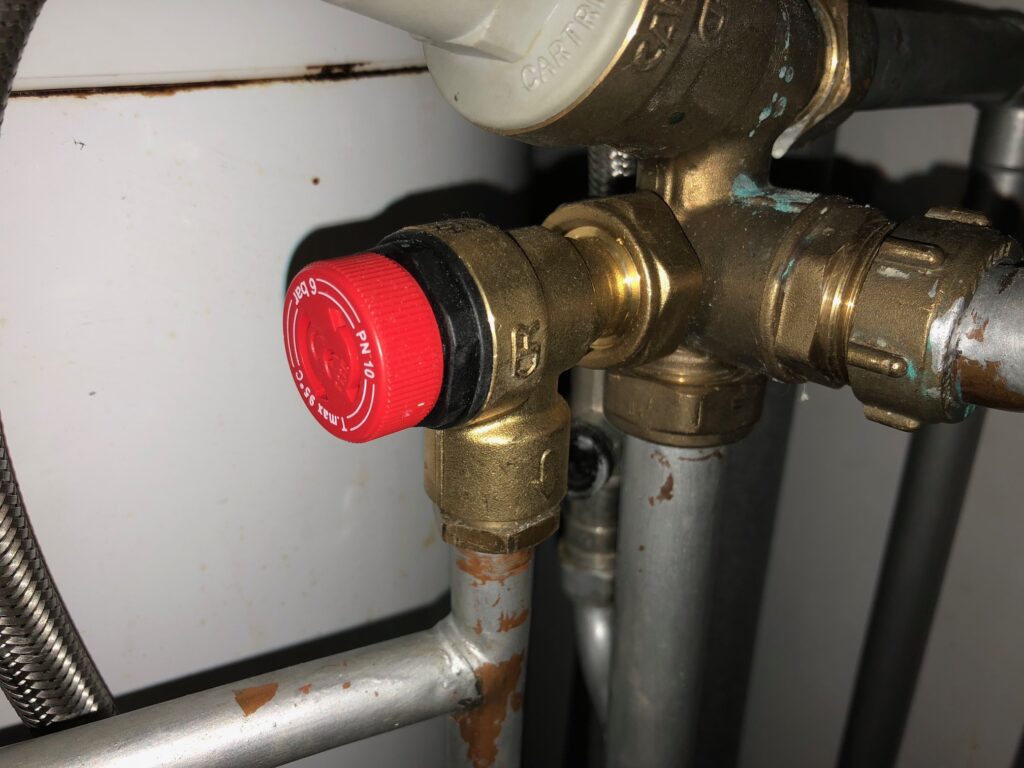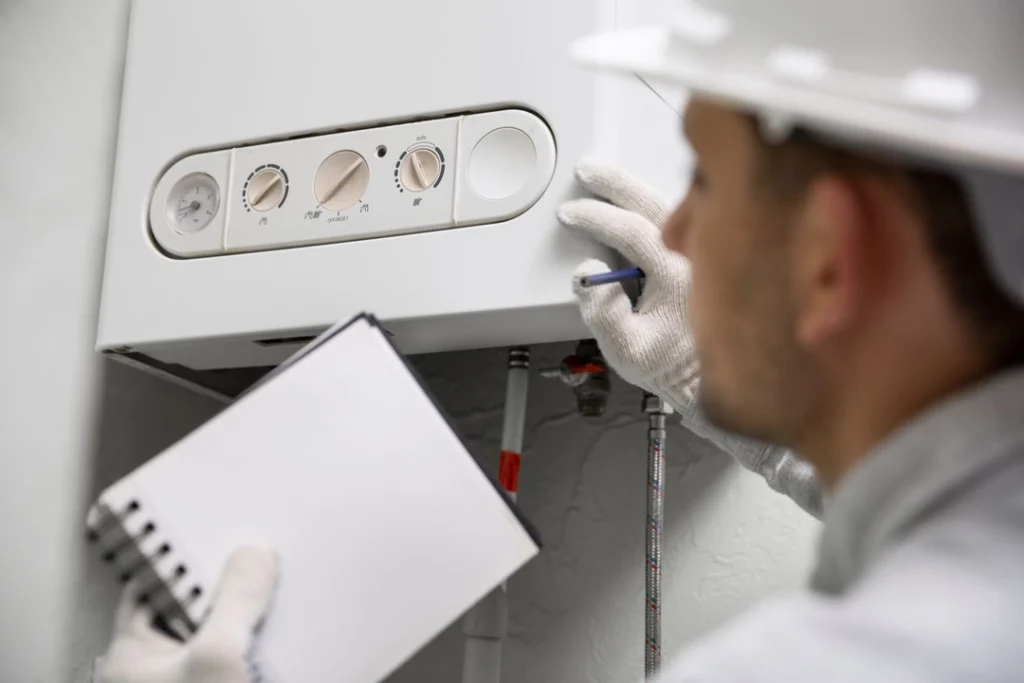A hot water boiler’s pressure relief valve is your home’s safety net. It stops dangerous pressure build-up before it causes damage.
Testing it isn’t just a good idea, it’s a must. With a quick check, you’ll know your system’s working safely and avoid costly breakdowns later.
How is a hot water boiler pressure relief valve tested?
Turn off power and fuel, let the boiler cool, lift the valve lever, and check for strong water flow that stops when released.
Key Takeaway
- The pressure relief valve is your boiler’s main safety feature.
- Test it yearly (or every 6 months for older systems).
- Always cool the boiler and wear protective gear before testing.
- Look for leaks, drips, rust, or weak flow as warning signs.
- Replace the valve if it fails or call a professional.
What is a Boiler Pressure Relief Valve?

Think of the pressure relief valve as your boiler’s safety net. It’s a small device with a big job: stopping pressure from building up to dangerous levels.
When water inside the boiler gets too hot, pressure rises. If it climbs past a safe limit, the valve pops open and releases water or steam. That quick action keeps your system from turning into a hazard.
Without it, you’d risk leaks, busted pipes, or worse. It’s not flashy, but it’s the unsung hero keeping your boiler steady and safe. Think of it like wondering how long does it take to install a water boiler, you don’t notice the importance until the moment it really matters.
Why Testing the Pressure Relief Valve is Important
Think of the pressure relief valve as your boiler’s bodyguard. It steps in when pressure climbs too high, keeping the tank from blowing off steam in the worst way.
If the valve’s jammed or weak, you’re basically sitting on a ticking time bomb. Water leaks, cracks, or even a burst tank can follow.
A quick test saves you from costly disasters and gives peace of mind that your system is ready for daily use. Checking the average boiler pressure is part of this—it’s not overkill, just a smart way to stay one step ahead of trouble.
How Often Should a Boiler Pressure Relief Valve Be Tested?
Once a year is the sweet spot. Think of it like your boiler’s annual health check.
If your system’s older or working overtime, every six months isn’t overkill. Quick tests keep you safe, cut down on surprise leaks, and save cash on repairs.
Bottom line: set a reminder, give it a quick test, and your boiler stays stress-free. If you’re ever curious about upkeep, it helps to know how does a boiler work for hot water, since understanding the basics makes maintenance easier.
Tools and Safety Precautions Before Testing
First things first, don’t even think about touching the relief valve without the basics. You’ll need a bucket or hose to catch water, work gloves, and safety glasses. That’s your starter kit.
Next, make sure the boiler is at a safe temperature. Testing when it’s piping hot is like grabbing a pan straight from the oven. Let it cool.
Cut the power supply and shut off the fuel source. No sparks, no drama. Then check the discharge pipe—clear it of clogs so the water has an exit route.
Bottom line: gear up, cool it down, and create a safe release path. Knowing the steps for how to shut down a boiler ensures you’re testing the valve, not testing your luck.
Step-by-Step Guide: How to Test a Hot Water Boiler Pressure Relief Valve
- Power Down First: Kill the power and fuel supply. You don’t want live heat messing with you while testing.
- Let It Cool: Boilers stay hot for hours. Give it time to chill so you’re not dealing with scalding steam.
- Find the Valve: Look for a small brass lever usually sitting near the top of the boiler. That’s your pressure relief valve.
- Place a Bucket Underneath: This valve releases water fast. Stick a bucket under the discharge pipe so you don’t flood the floor.
- Lift the Lever: Gently flip the lever up. You should hear water rushing out. That’s the system saying, “I’m alive.”
- Watch the Flow: Strong flow of hot water? Good sign. Weak trickle or nothing? That valve’s probably toast.
- Let It Snap Back: Drop the lever back down. The water should stop flowing instantly. If it drips, the seal isn’t tight anymore.
- Check for Leaks: A steady drip from the valve is a clear sign it’s worn out and needs replacing. If you’re unsure where to start, learning how to repair a boiler leak can help you identify whether the valve or another part is causing the issue.
- Clean Up and Reset: Toss the bucket water, dry things off, and restart your boiler once everything’s secure.
- Replace If Needed: If your valve failed any part of this test, don’t ignore it. Get a new one fitted before cranking the boiler back up.
Signs the Pressure Relief Valve May Need Replacement
- Constant Drips: If water keeps dripping from the valve, it’s not just “sweating.” That’s a red flag.
- Rust or Corrosion: Spotting rust or mineral build-up? That means the valve’s fighting a losing battle.
- Stuck Lever: If the test lever feels jammed or flimsy, the valve isn’t pulling its weight.
- Weird Noises: Hissing, gurgling, or whistling from the valve isn’t normal. It’s crying for a swap.
- No Release During Test: If nothing comes out when you lift the lever, that’s your cue to replace.
Common Mistakes to Avoid During Testing
- Skipping the cool-down: Testing a valve on a hot boiler? That’s asking for burns. Always let it chill first.
- Forcing the valve: Don’t yank it like it owes you money. A steady lift does the trick without damage.
- Ignoring leaks: If water drips after testing, that’s not “normal.” It’s a red flag you need to fix.
- No protective gear: Hot water and steam aren’t fashion accessories. Gloves and eye protection keep you safe.
When to Call a Professional

If the relief valve leaks nonstop or refuses to reset, it’s not a quick DIY fix. You’ll need a pro to step in. Strange noises, constant pressure spikes, or water pooling near the boiler are also red flags.
Don’t take chances with safety, schedule professional help when your heating system acts up. A certified technician experienced in boiler repair in Warren will make sure your unit runs smoothly, cleanly, and safely.
Frequently Asked Questions
1. How often should I test the pressure relief valve?
Once a year is usually enough. It keeps you safe and your boiler stress-free.
2. What if water keeps dripping after testing?
That’s a red flag. The valve may be worn out and needs replacing.
3. Can I skip testing if my boiler’s new?
Nope. Even new gear can fail. Quick checks save you from expensive headaches later.
Conclusion
Testing a hot water boiler pressure relief valve isn’t rocket science, but it’s non-negotiable for safety. A quick check keeps leaks, bursts, and surprise repairs off your calendar.
If you’re unsure or spot anything sketchy, call in a pro. Think of it as cheap insurance for peace of mind and a longer-lasting boiler.